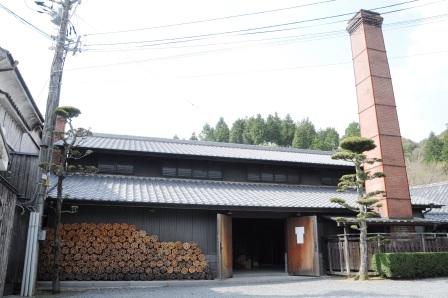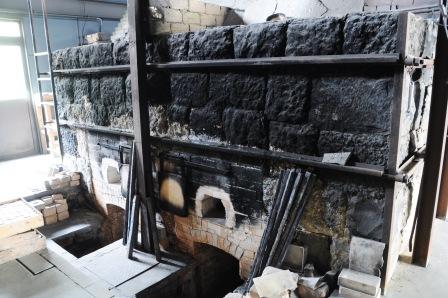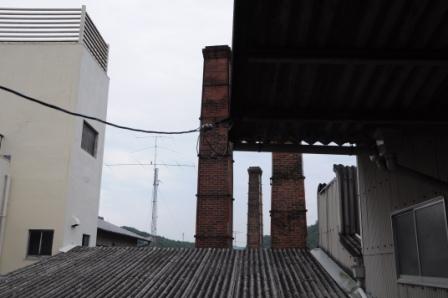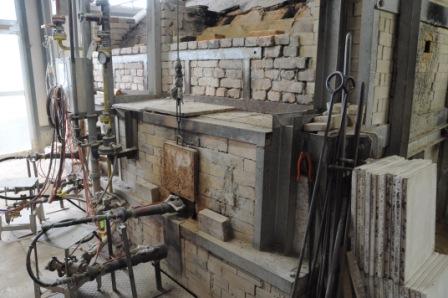Japanese Potteries (Story of Kilns)
What's necessary to produce potteries are some clay and a kiln. It'll be all right with the two. I have given a story of clays last time so it is now for kilns.
Actually there are so many kinds of kilns. It is because, in the process of development of potteries, they have been developed to suit what to be made time by time. Now let's see the passage of history at first.

Arita Gen-emon
Dating as far back as 13,000 B.C., the Jomon people who had discovered fire came to know that clays went tight in heat. That was the start of clay pots. Clay figures to pray for a safe delivery of baby or for fertility and harvest, or clay pots for cooking were laid in dips and baked with plants and trees. In such open burning, those were in reddish and bright color by getting oxidized, and produced a dull sound when tapped. Even now the same way of baking is used when making Kawarake (a kind of small clay dishes).
At around the 3rd century B.C., such style of baking in dips began to change: they created some walls around the dips and obtained higher temperature to bake. Thanks to the higher temperature, they could produce clay pots thinner and in less oxidation, which surface color were in white, gray or black. After 10,000 years of such open burning, the production of something that looked like kilns finally began by the diffusion of technics from the Korean Peninsula. In those days, at the Korean Peninsula, there were many kilns set underground, which the fire hole was at 2 meters under ground and people seemed to throw firewoods into it from above. This type of kiln with a wall toward fire hole was eventually be applied to kilns for Goryeo celadon porcelain in the 11th century, too.
In the 11th century, kilns which shape didn't differ much from that of present Anagama (cave kilns) began to appear. An Anagama kiln was shaped like a tunnel with width that gradually get narrower from the fire hall to the direction of smoke path, and was then connected to the chimney. As it had no partitions inside, they controlled the surge of flame by laying products in various sizes combined well.
Such kiln with inside walls to divide the space was the split bamboo kiln that could be seen in the 15th century. It was a kiln that was just shaped like a half-split bamboo faced down, which could create higher thermal efficiency and longer retention time of flare by having partitions. In the similar time, a type of kiln with a pillar called bunen-chu near the fire hall was also produced. This pillar was for dividing the surge of flame and for increasing the size of kilns, from which we can realize that the pottery production would have been expanded.

The kiln of Arita Gen-emon
This is what happened within 100 years Every rapid technical innovation and potter's unending challenge-spirits pulled the porcelain industry up to the world level.
If you actually fire a kiln , in as the temperature goes up, it flares harder and the flame goes through to the chimney violently. These types of kilns may emerged as the fruit of wisdoms of workmen at those times who attempted to control such uncontrollable flame for making their products as good as possible.
In the 18th century, Renboshiki-noborigama (multi-chambered climbing kiln) appeared, that could be made finally after the development of the split bamboo kiln or the anagama with bunen-chu. By making each firing room of split bamboo kiln round like pies, it enabled flame to sweep across inside the kiln. Even now, such renboshiki-noborigama is common as one of the wood-fired kilns. What was epoch-making on the kiln was that the way of baking or temperature could have been changed at each chamber. Therefore, it came to be able to bake various kinds of products at a single firing opportunity. Taking Bizen-yaki for example, it's a way like using the first chamber for Goma-yaki (a way of baking, having plenty ashes scattered on the surface of product, which is called so because the ashes on surface look like goma-sesames), then next chamber for Hidasuki (a way of baking, having works wrapped with straws and the part contacting with straws turns red) in a highly oxidized condition, then next for Sangiri (a way of baking, putting charcoals or having it far less oxidized to create a varied appearance of potteries).

Bizen To-sho-en
As such, wood-fired kilns had been used for a long time, however, in the 20th century, fuels used in firing have been altered to something more efficient in burning such as charcoal, kerosene, or gas. With the development of the industry, kilns have become bigger. And, on the contrary, many smaller kilns also appeared with the growing population of individual workmen. The diffusion of electric kilns that have no chimney enabled people to bake potteries even in their houses or units of condominium units.
Now that we have seen the transition of kilns as above, some basic questions may arise. Nowadays,various workmen own various types of kilns and bake potteries in various ways, but what will be the difference upon using different types of kilns? Or no difference? After this, we'll look at noborigama, kerosene-kiln, gas-kiln, electric-kiln from the respective aspects of installation, cost, and mood of finished potteries.
Let's see about installation first. It can be easily imagined that not everyone can build up a noborigama. You need to have a broad land and understanding of neighbors for the black smoke billowing out. Kyoto is a place that has plenty kilns traditionally, but they have no longer used noborigama in town in consideration for impacts to neighbors. You may feel less stressed in installing a kerosene-kiln compared with noborigama but it still emits some smoke, as well as the smell of kerosene and and the noise of fans that supply kerosene to the kiln, for which you may need neighbors' understanding. A gas kiln does not emit any smoke, bad smell or noise, but it still needs to have a chimney and pipeworks from a gas cylinder. As it may go off as the gas pressure won't be stable in a lower temperature, you must keep paying attention. An electric kiln can be used anywhere, as I mentioned earlier, even in a condominium unit. You may just feel easy and unstressed in using it as one of a little big electric appliances in your room, except for the one in a larger size that may require an extensive power distribution work.
Next is the cost. The order from higher in cost is noborigama, electric kilns, gas kilns and then kerosene kilns. Though it is subject to change due to the price fluctuation of kerosene or gas, or the circumstance in which for example you can obtain firewoods by yourself or you can generate electricity at the place.

The kiln of Bizen To-sho-en
In considering such aspects, then what is the point to build a noborigama that costs a lot and makes terrible impact to neighbors? Even now there are lots of potteries produced in the persistency to wood-fired kilns. The first thing I say is that they have a kind of yearning toward the times that the original clay at each place had been fired with firewoods. The full of expression of clay and glaze can never be created with electric kilns, that is made in being exposed by humidity from ground, in being stressed by the fierce changes of temperature with repeated oxidation and reduction, and in being passed through terrible blaze. If you find the real strength and beauty of potteries in such expressions, you should pursue the path in a risk-taking attitude.
However, obtaining such circumstance for noborigama may not be that easy, so you have the alternatives to go for a kerosene kiln or a gas kiln that exposes your works to flame. In a kerosene kiln, your product goes through the flame for a comparatively long time. A kerosene kiln will create a good soft mood of potteries by firing with neutral flame, in between oxidized flame and reduced flame. A gas kiln is good at reduced firing, which is good for baking celadon or white porcelains. The atmosphere in the gas kiln can be controlled by adjusting a damper of chimney (adjusting the extent of smoke path) and a draft (to send air into the smoke path), having a look at the condition of flame from the opened window in the front. An electric kiln is flameless with having no chimney. It's good at oxidized firing, which is good for making crisp Uwae(s) that disfavors humidity. However, you can conduct reduced firing as well by using an attached burner. It's also very good for cooling reduction, a way of baking which keeps the reduced condition while cooling down, because no outside air comes in structurally.
Therefore, each type of kiln is respectively suitable for making some kinds or moods of potteries. If you have an opportunity to visit a workman or pottery, you'd better ask them to show you the kiln. There should be final dramatic scenes to create a piece of work, where you may see some failed works scattered around the kiln or find out how the works are sensitive from their sample works for colors. I believe that you'll grow fond of your dishes or pots that you usually use once you get to know the different side of potteries you see everyday.
